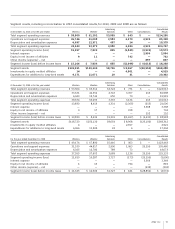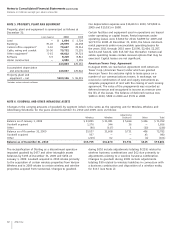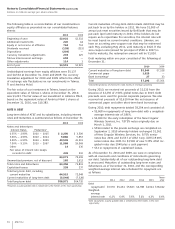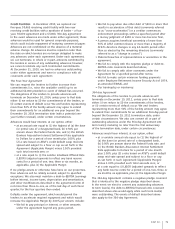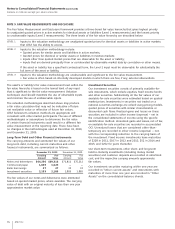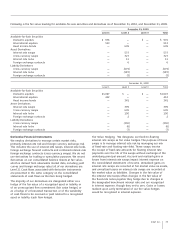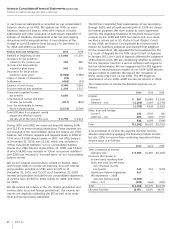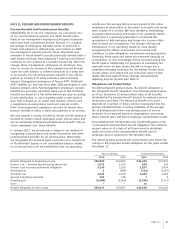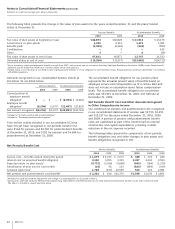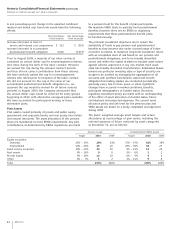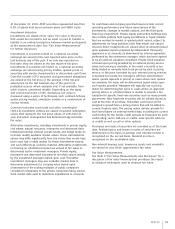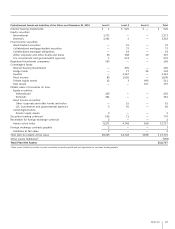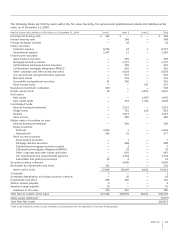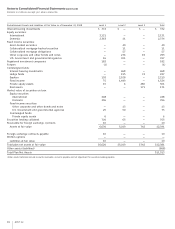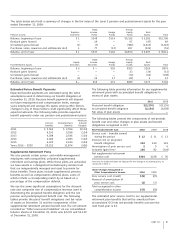AT&T Wireless 2010 Annual Report Download - page 83
Download and view the complete annual report
Please find page 83 of the 2010 AT&T Wireless annual report below. You can navigate through the pages in the report by either clicking on the pages listed below, or by using the keyword search tool below to find specific information within the annual report.
AT&T Inc. 81
results over the average future service period of the active
employees of these plans, to the extent such gains and losses
were outside of a corridor. We have elected to immediately
recognize actuarial gains and losses in our operating results,
noting that it is generally preferable to accelerate the
recognition of deferred gains and losses into income rather
than to delay such recognition. This change will improve
transparency in our operating results by more quickly
recognizing the effects of economic and interest rate
conditions on plan obligations, investments and assumptions.
Generally, these gains and losses are measured annually as
of December 31 and accordingly will be recorded during the
fourth quarter. Additionally, for purposes of calculating the
expected return on plan assets, we will no longer use a
permitted averaging technique for the market-related value
of plan assets but instead will use actual fair value of plan
assets. We have applied these changes retrospectively,
adjusting all prior periods (see Note 1).
Obligations and Funded Status
For defined benefit pension plans, the benefit obligation is
the “projected benefit obligation,” the actuarial present value,
as of our December 31 measurement date, of all benefits
attributed by the pension benefit formula to employee service
rendered to that date. The amount of benefit to be paid
depends on a number of future events incorporated into the
pension benefit formula, including estimates of the average
life of employees/survivors and average years of service
rendered. It is measured based on assumptions concerning
future interest rates and future employee compensation levels.
For postretirement benefit plans, the benefit obligation is the
“accumulated postretirement benefit obligation,” the actuarial
present value as of a date of all future benefits attributed
under the terms of the postretirement benefit plan to
employee service rendered to the valuation date.
The following table presents this reconciliation and shows the
change in the projected benefit obligation for the years ended
December 31:
NOTE 11. PENSION AND POSTRETIREMENT BENEFITS
Pension Benefits and Postretirement Benefits
Substantially all of our U.S. employees are covered by one
of our noncontributory pension and death benefit plans.
Many of our management employees participate in pension
plans that have a traditional pension formula (i.e., a stated
percentage of employees’ adjusted career income) and a
frozen cash balance or defined lump sum formula. In 2005,
the management pension plan for those employees was
amended to freeze benefit accruals previously earned under a
cash balance formula. Each employee’s existing cash balance
continues to earn interest at a variable annual rate. After this
change, those management employees, at retirement, may
elect to receive the portion of their pension benefit derived
under the cash balance or defined lump sum as a lump sum
or an annuity. The remaining pension benefit, if any, will be
paid as an annuity if its value exceeds a stated monthly
amount. Management employees of former ATTC, BellSouth,
AT&T Mobility LLC and new hires after 2006 participate in cash
balance pension plans. Nonmanagement employees’ pension
benefits are generally calculated using one of two formulas:
benefits are based on a flat dollar amount per year according
to job classification or are calculated under a cash balance
plan that is based on an initial cash balance amount and
a negotiated annual pension band and interest credits.
Most nonmanagement employees can elect to receive their
pension benefits in either a lump sum payment or an annuity.
We also provide a variety of medical, dental and life insurance
benefits to certain retired employees under various plans and
accrue actuarially determined postretirement benefit costs as
active employees earn these benefits.
In January 2011, we announced a change in our method of
recognizing actuarial gains and losses for pension and other
postretirement benefits for all benefit plans. Historically,
we recognized the actuarial gains and losses as a component
of Stockholders’ Equity on our consolidated balance sheets
on an annual basis and amortized them into our operating
Pension Benefits Postretirement Benefits
2010 2009 2010 2009
Benefit obligation at beginning of year $50,850 $50,822 $36,225 $37,531
Service cost – benefits earned during the period 1,075 1,070 348 334
Interest cost on projected benefit obligation 3,150 3,355 2,257 2,434
Amendments 2 (685) (742) (3,115)
Actuarial loss 4,224 2,439 1,046 1,402
Special termination benefits 101 118 7 9
Benefits paid (5,485) (6,269) (2,536) (2,370)
Other — — 33 —
Benefit obligation at end of year $53,917 $50,850 $36,638 $36,225


